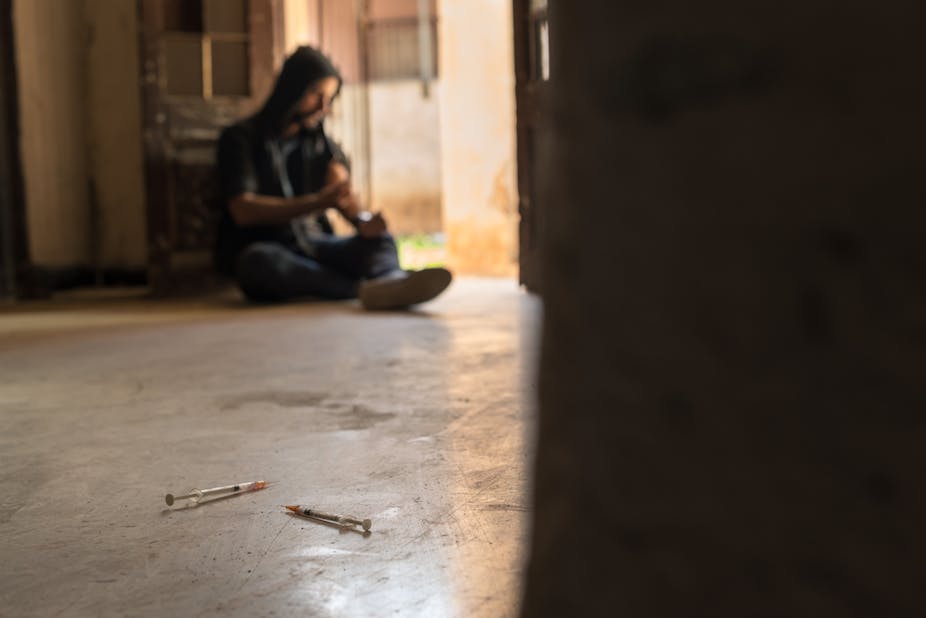If drug users cannot be dissuaded from taking drugs, is it better to help ensure their drug-taking is as safe as possible? This is the harm-minimisation approach that Glasgow City Council is taking with its proposal to open a facility for heroin users. This safer drug consumption facility, sometimes referred to in the press as a “fixing room” would provide clean needles, safe spaces and medical supervision alongside advice, treatment referral and a number of other facilities. In some cases, where current treatments were unsuccessful, users may be offered medical-grade heroin, diamorphine.
This not uncontroversial idea is aimed at a small but vulnerable group of drug users who inject drugs in public places. Street use causes problems for the wider community, such as discarded needles, but also poses great risks to users, who face increased risk of infection, blood-borne viruses or overdose. Glasgow council’s proposal arrives following a significant increase in HIV infections and drug-related deaths among addicts.
The Glasgow proposal would be the first facility to open in the UK, although as part of a King’s College London research study, limited trials in 2007 involved giving heroin to addicts in special clinics in London, Darlington and Brighton. Drug consumption rooms have been introduced in ten other countries including Switzerland, Germany, the Netherlands, Spain, Norway, Australia and Canada.
All are supervised by trained staff and have a number of rules and regulations about who can access them and what behaviour and practices are allowed. Often these are set up near to known drug markets, so drug users can take their recently purchased drugs in a clean, safe environment – rather than injecting in alleys, parks, stairwells or public toilets.
Drugs policy expert Professor Neil McKeganey has expressed concerns about the proposal, doubting that it would reduce rates of heroin use and heroin-related deaths. He claims there is no evidence that the facility would work. Certainly a lack of evidence was the reason successive UK governments have rejected the idea, most recently in 2006. However, the experience of countries where such facilities are allowed has shown that they have been successful in reducing HIV infections, drug overdoses and issues surrounding public injecting and discarded needles.
While there is often public opposition to drug consumption rooms, studies that have evaluated their use in other countries conclude that they are cost effective, often reach the most vulnerable drug users and lead to less public nuisance. Initial public resistance towards them was found to fall once they had opened.
For drug consumption rooms to be successful, a key group of people that must be persuaded are the drug users themselves. We conducted a study of attitudes towards safer consumption facilities among current or former injecting drug users, mainly heroin users. We found they were largely in favour and would make use of them if one were to open nearby. They were also willing to abide by the rules that using such a facility would require – such as no drug sharing.
While the respondents gave various reasons for public injecting, the majority who had injected in public places in the previous month did so out of necessity – despite only around a third being homeless – and would rather have an alternative. Some felt injecting in public was degrading, while others did not wish to be seen by children.
One aspect that drug users were not in favour of, however, were rules forbidding injecting in the neck or groin – rules common to these sorts of facilities in other countries.
Those users with a long history of injecting and who use public places are at high risk of death from overdose – and it is these high-risk users that are being targeted, as they stand to benefit most from the facilities provided by drug consumption rooms.
So studies have shown that safe consumption facilities can succeed in reaching long-term drug users who have had no previous contact with treatment services, and can be effective in getting some users of the facility into treatment programmes. A centre such as the one proposed in Glasgow, which still requires legal approval, would need to be monitored – and should be only one part of a strategy to address problem drug taking. But if it reduces the harms of public injecting, reduces HIV infection rates, overdoses and deaths among some of society’s most vulnerable people, then it may be that the time has come to trial a different approach.

